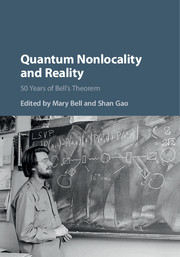Book contents
- Frontmatter
- Contents
- Contributors
- Preface
- Preface
- Part I John Stewart Bell: The Physicist
- Part II Bell's Theorem
- 4 What Did Bell Really Prove?
- 5 The Assumptions of Bell's Proof
- 6 Bell on Bell's Theorem: The Changing Face of Nonlocality
- 7 Experimental Tests of Bell Inequalities
- 8 Bell's Theorem without Inequalities: On the Inception and Scope of the GHZ Theorem
- Part III Nonlocality: Illusion or Reality?
- Part IV Nonlocal Realistic Theories
- Index
- References
5 - The Assumptions of Bell's Proof
from Part II - Bell's Theorem
Published online by Cambridge University Press: 05 September 2016
- Frontmatter
- Contents
- Contributors
- Preface
- Preface
- Part I John Stewart Bell: The Physicist
- Part II Bell's Theorem
- 4 What Did Bell Really Prove?
- 5 The Assumptions of Bell's Proof
- 6 Bell on Bell's Theorem: The Changing Face of Nonlocality
- 7 Experimental Tests of Bell Inequalities
- 8 Bell's Theorem without Inequalities: On the Inception and Scope of the GHZ Theorem
- Part III Nonlocality: Illusion or Reality?
- Part IV Nonlocal Realistic Theories
- Index
- References
Summary
Abstract
While it is widely agreed that Bell's theorem is an important result in the foundations of quantum physics, there is much disagreement about what exactly Bell's theorem shows. It is agreed that Bell derived a contradiction with experimental facts from some list of assumptions, thus showing that at least one of the assumptions must be wrong; but there is disagreement about what the assumptions were that went into the argument. In this paper, I make a few points in order to help clarify the situation.
Introduction
Different authors have expressed very different views about what Bell's theorem shows about physics. The disagreement concerns particularly the question of which assumptions go into the argument. Since we have to give up one of the assumptions leading to the empirically violated Bell inequality, knowing what the assumptions were is crucial. For example, if author X believes that the argument requires only one assumption, A1, while author Y believes that it requires two, A1 and A2, then X will conclude that A1¬ must be abandoned, while Y will conclude that either A1 or A2 must abandoned, so A1 may well be true in our world if A2 is false. In this paper, I consider several assumptions that have been mentioned in connection with Bell's theorem, and I look into their roles in the proof of Bell's theorem. While I do not say anything here that has never been said before, I hope that my remarks can nevertheless be helpful to some readers.
For the sake of definiteness, the version of the relevant experiment that I will consider involves two spin-1\2 particles, initially in the singlet spin state ψ = 2−1/2(|↑↓ ⟩ − |↓↑ ⟩). Two widely separated experimenters, Alice and Bob, have one particle transported to each of them. At spacelike separation, they each choose a direction in space, represented by the unit vectors a and b, and carry out a quantum measurement of the spin observable in this direction on their particle, (a · σ) ⊗ I and I ⊗ (b · σ), with I the 2 × 2 unit matrix and σ the triple of Paulimatrices. The possible outcomes, A and B, are±1 on each side. Bell's theorem is the statement that under the assumptions we are about to discuss, Bell's inequality holds; quantum theory predicts violations of Bell's inequality, and experiments have confirmed these predictions.
- Type
- Chapter
- Information
- Quantum Nonlocality and Reality50 Years of Bell's Theorem, pp. 79 - 90Publisher: Cambridge University PressPrint publication year: 2016
References
- 4
- Cited by



